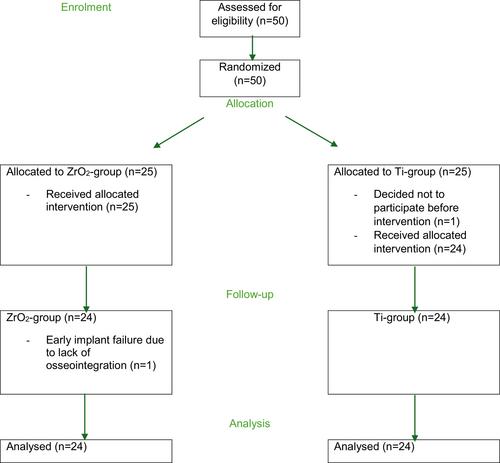A randomized clinical trial on zirconia versus titanium implants in maxillary single tooth replacement
Abstract
Objectives
This RCT aimed to compare zirconia and titanium dental implants in the maxillary premolar region. The comparison was based on marginal bone level (MBL) changes, clinical parameters, aesthetic outcomes, and patient related outcome measures (PROMs) 1 year after prosthetic loading.
Materials and Methods
Fifty patients were randomly assigned to receive either a zirconia (ZrO2, n = 25) implant or a titanium (Ti, n = 25) bone-level implant. Implants were provided with a lithium disilicate crown 3 months after placement. Follow-up was at 1 month and after 1 year. The primary outcome pertained to changes in MBL. Reported secondary outcomes consisted of implant survival, peri-implant tissue health, aesthetics, and PROMs.
Results
Mean MBL change after 1 year was 0.01 mm (SD = 0.45; min = 0.72, max = 0.86) for ZrO2 and −0.09 mm (SD = 0.34; min = 0.53, max = −1.06) for Ti (p = .439). Scores for the other clinical outcome parameters and PROMs were generally favorable, with no significant differences. However, significant differences were found for the aesthetic outcomes regarding two criteria: (a) level of facial mucosa (p = .022), in favor of Ti, and (b) root convexity/soft tissue color and texture (p = .005) in favor of ZrO2.
Conclusion and clinical implications
The ZrO2 and Ti implant types used in this study, replacing a single missing maxillary premolar, show a comparable outcome in terms of MBL change after 1 year. Clinical and aesthetic parameters, as well as PROMs, are favorable and similar between both implant types after 1 year of prosthetic loading. These short-term study results suggest that both are suitable for clinical use.


 求助内容:
求助内容: 应助结果提醒方式:
应助结果提醒方式:


